Keenan Yakola
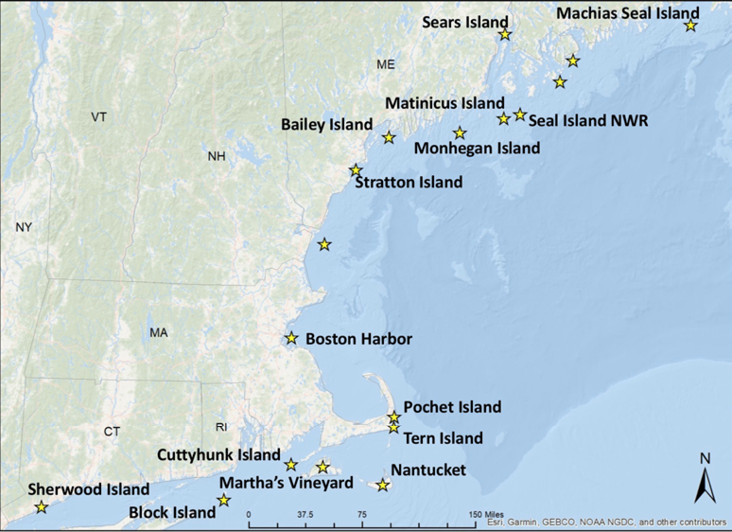
Island overview. All images courtesy of the author.
Islands are intriguing. Different from the mainland, they pique our curiosity. The New England coast is dotted with islands, several of which are magnets for migrating birds and are also accessible to people, making them even more appealing to birders. Island birding covers the spectrum from large, well-known hotspots where birders can explore for days on end to small, sandy or rocky outcrops where visitors may spend only a few hours. This guide provides a brief overview to birding the islands off New England with the exception of the Boston Harbor islands, which merit a birding overview of their own. (See John Nove's "Birding the Boston Harbor Islands" in Bird Observer June 2001.)
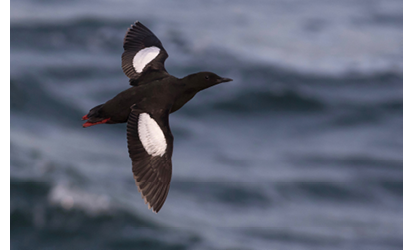
Black Guillemot.
Southern New England Islands
Sherwood Island State Park, Connecticut
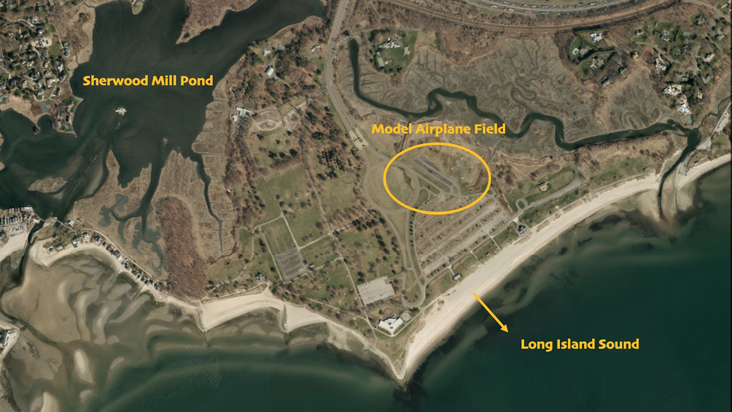
Best time to visit: Best in fall but good year-round.
Sherwood Island State Park is the top eBird hotspot in Connecticut with over 300 recorded species! Lots of rarities have been found on the island including Sprague's Pipit, Western Meadowlark, Ash-throated Flycatcher, Sabine's Gull, Boreal Chickadee, Ruff, Eared Grebe, Smith's Longspur, Golden Eagle, and Painted Bunting; many of these have been found in the fall. It's also a good place to check for Boat-tailed Grackle. If you are unsuccessful here, you can also take a quick drive up to Stratford Point.
Birders visiting the park should walk the beach and scope Long Island Sound. Also walk the model aircraft field and along the edge of the marsh. Check out the Sherwood Millpond from the west-end viewing platform at any time of year. The spruce grove area can be excellent during spring and fall migration and is certainly worth some time exploring.
Directions: take Exit 18 from Interstate 95 (I-95) North or South to access the Sherwood Island Connector. Follow the connector directly into the park.
Links: Sherwood Island State Park; eBird Hotspot
Block Island, Rhode Island
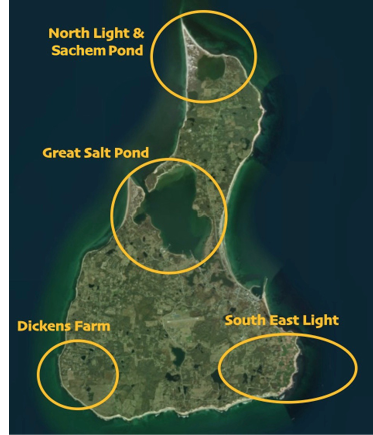
Best time to visit: spring and especially fall migration.
Block Island is a great spot to enjoy falcon migration in the fall and search for migrating songbirds. Keep your eye out for vagrants as a long list of rarities have been found here including Northern Lapwing, Bewick's Wren, Brown Noddy, Phainopepla, Eurasian Jackdaw, Northern Wheatear, Fork-tailed Flycatcher, Say's Phoebe, American White and Brown pelicans, and Mississippi Kite.
Start your birding route at North Light and the thickets around Sachem Pond. Working south, check the Great Salt Pond area for shorebirds, then check roadside thickets and trails for migrants as you work your way back toward the town site. Eventually travel south toward Southeast Light along the roadways above the Mohegan Cliffs, and if time allows explore Lewis-Dickens Farm on the southwest corner of the island. This route affords good coverage and offers plenty of time for lingering at especially birdy spots.
Access Block Island via the ferry from Point Judith or a flight from Westerly, Rhode Island:
Ferry Service / Flight Service
Links: accommodations; eBird Hotspot
Also see: Bird Observer's Block Island (Fox 2000)
Cuttyhunk Island, Massachusetts
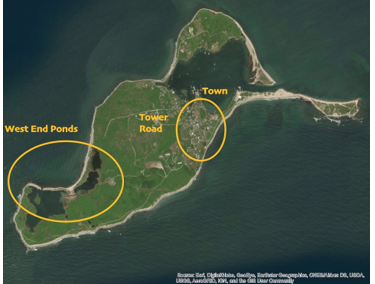
Best time to visit: spring and especially fall migration.
Highlights include Purple Gallinule, Varied Thrush, Yellow-rumped Warbler (Audubon's), and Cave Swallow. According to Ian Davies, "Cuttyhunk is one of those places on the edge of things, where it feels like every step could turn up something incredible."
After disembarking the ferry, you are already close to some of the island's best birding, which is along the streets that cross through town. Walk up and down all of the streets a few times, and it is worthwhile to spend a bit of time around the small pond, too. From there, go to the top of Tower Road and check the thickets along the raised road, which can be quite productive. A visit to Cuttyhunk would not be complete without visiting the larger marshy ponds at the western end of the island. Take West End Road, which goes through groves of poplars that also can be quite birdy.
Access the island via the ferry from New Bedford
Link: eBird Hotspot
Martha's Vineyard, Massachusetts
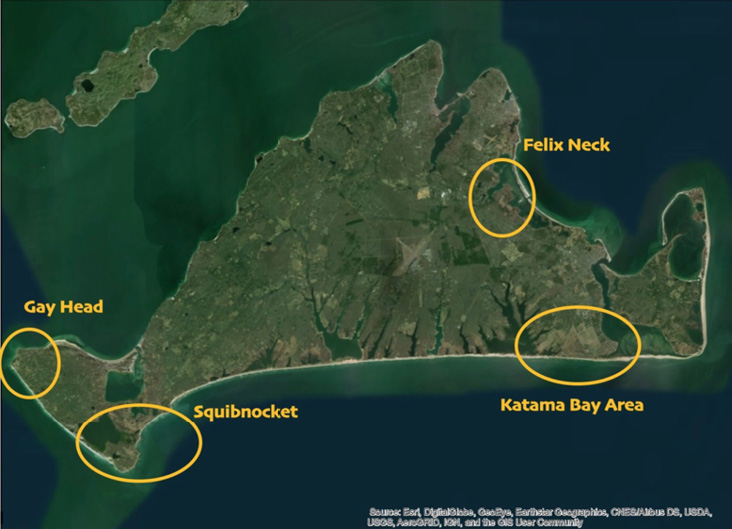
Best time to visit: fall migration.
Martha's Vineyard boasts a long list of rarities including Red-footed Falcon, Common Cuckoo, Gray Kingbird, Zone-tailed Hawk, Magnificent Frigatebird, Northern Lapwing, Long-billed Curlew, Eurasian Curlew, Black-tailed Godwit, Curlew Sandpiper, Sulfur-bellied/Streaked Flycatcher, and Bridled Tern.
The suggested birding route starts at the Gay Head cliffs in Aquinnah. This location offers excellent morning flights of songbirds in September and October and is also a good spot to watch falcon migration. Bird the thickets here and spend time scanning the ocean for seaducks. After spending the morning at Gay Head, head east and consider stopping at any good-looking thickets along the way. A nice route to take is through Squibnocket.
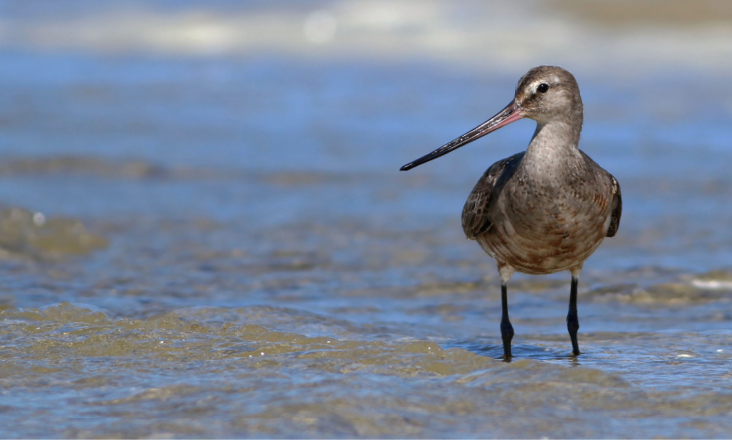
Hudsonian Godwit.
Eventually you will want to get to the Katama Bay area. Lots of good places to visit here including the farm institute fields and the airfield (where the Red-footed Falcon was seen in 2004). From Katama Point you can scan the flats of the bay for shorebirds. If you have time, take a walk around Norton Point. Finish the day at Mass Audubon's Felix Neck Wildlife Sanctuary where you may get a chance to see Barn Owls exiting their nest box on the property.
There are several options for getting to Martha's Vineyard but I suggest taking the ferry from Woods Hole. The ferry ride is relatively short and good birding can be enjoyed from the boat itself.
Links: Felix Neck Wildlife Sanctuary
Nantucket, Massachusetts
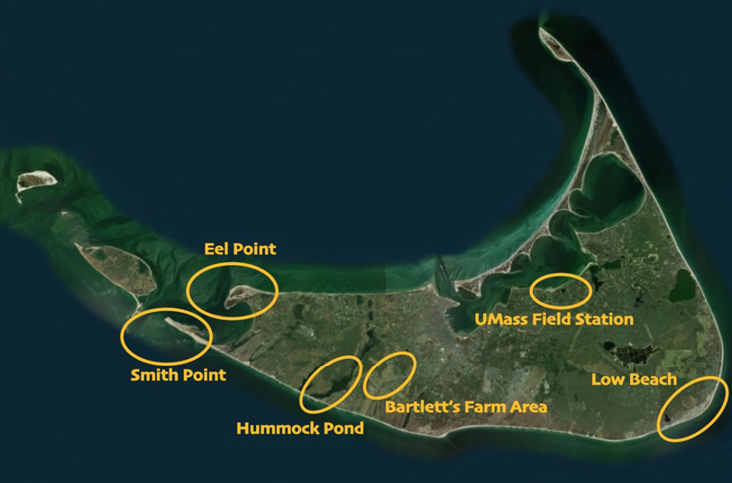
Best time to visit: fall migration and early winter.
The extensive list of rarities is highlighted by Western Reef Heron, Grey-tailed Tattler, Northern Lapwing, Magnificent Frigatebird, Black-backed Woodpecker, Black-chinned and Calliope hummingbirds, California Gull, and Northern Wheatear.
A great place to start the day is at either Smith or Eel point on the west end of the island. It is best to be here early in the morning to observe large migrant flights in the fall (weather dependent) and Long-tailed Duck flights in the winter. Traveling eastward, stop at the Horse Farm lookout at Hummock Pond. American Avocet, Scissor-tailed Flycatcher, Northern Lapwing, and Cattle Egret have been observed here. Just around the corner, take the road through the Bartlett's Farm fields. Do not trespass, and observe only from the road. This is a good location for geese in the winter and for shorebirds in the fall. Ross's Goose, Baird's and Pectoral sandpipers, and Black-necked Stilts have been seen here.
It is always worth stopping along Low Beach Road south of Siasconset. This can be a big hotspot for gulls especially from fall to early spring. Lesser Black-backed Gull can be a relatively common sight among the regulars. Little, Blacked-tailed, and Mew gulls also have been recorded at this location. Finally, if you have some extra time, try to stop by the UMass Boston Nantucket Field Station and check out the small marsh there. This is where the Grey-tailed Tattler and Western Reef Heron were seen.
If you take the slow ferry from Hyannis, you can bird while crossing Nantucket Sound, but the trip takes around 2.5 hours. It's difficult to bird from the fast ferry, but you'll arrive in Nantucket in an hour.
Links:
- Like Martha's Vineyard, Nantucket has many eBird hotspots, so here is the link to Nantucket County.
- Check out Birding Nantucket (Andrews and Blackshaw 2014) for more information.
- Check out Bird Observer's Where to Go on Nantucket (Veit 1976).
Tern Island, Massachusetts
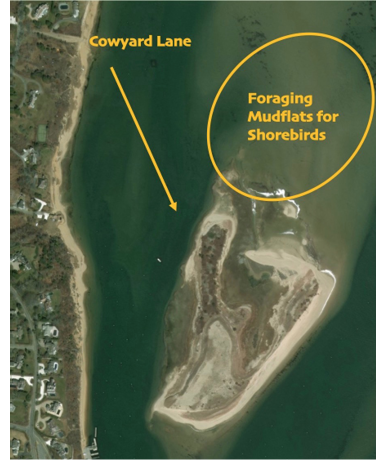
Best time to visit: mid-July through October.
A visit here is highlighted by excellent views of shorebirds of all kinds. Rarities including Curlew Sandpiper, Bar-tailed Godwit, Little Gull, and Black-headed Gull have been recorded at this location. You'll want to be at Tern Island about 1.5–2 hours before or after high tide in Chatham Harbor for the best birding (The mud flats which harbor shorebirds are covered by water during high tide). The goal is to watch the flats just as they are opening or as they close up as this is when the highest concentration of shorebirds gather on the island. I suggest that you arrive just after low tide and enjoy the shorebirds as the flats close up.
The flats on Tern Island will cover up before areas that are farther up in Pleasant Bay. If you can find a good spot (where you are not disturbing any nesting species) look east toward North Beach Island and you can watch shorebirds departing Pleasant Bay and flying south to roost during the high tide. Sometimes these flocks can be quite large and can contain high numbers of Red Knots, Black-bellied Plovers, and Sanderling with many other species mixed in.
While out on Tern Island or anywhere in Chatham it's a good idea to keep your eye out for banded shorebirds, especially Red Knots, which commonly feed on mussel spat. In addition, please respect all symbolic fencing to protect nesting shorebirds, and sensitive habitat. The island is owned and maintained by Mass Audubon.
You can view Tern Island from Cow Yard Lane in Chatham. Or you can park for free at Cow Yard Lane and kayak out to the island, a trip that will take only a few minutes. Occasionally, Mass Audubon's Wellfleet Bay Wildlife Sanctuary will run planned trips during July and August.
Links: Wellfleet Bay Wildlife Sanctuary; Tern Island; Cow Yard Lane
Pochet Island, Massachusetts
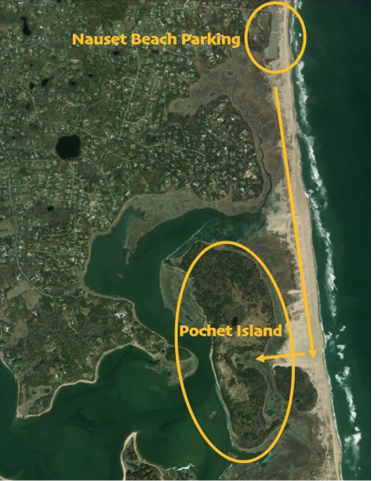
Best time to visit: spring or fall migration.
Highlights include; Cave Swallow, American White Pelican, Yellow-throated Vireo (can be a tricky bird on Cape Cod), Summer Tanager, Yellow-rumped Warbler (Audubon's), and marsh birds such as rails and sparrows when you cross the bridge through the marsh.
Start your birding route at the Nauset Beach parking lot in Orleans, Massachusetts, the earlier the better. Walk south on either the ORV trail or the beach. Keep a close eye on the marshes to west. They often are a good place to see falcons, harriers and occasionally Short-eared Owls. Lots of trails maintained by the Pochet Island Association cover the island and any of the field edges could produce migrant songbirds. Scan the marshes and water west and south of the island for ducks. Additionally, check the small freshwater pond on the island. Skulking migrants such as Yellow-breasted Chat like to haunt the edges of the pond in the fall.
It's a bit of a hike to access the island. Unless you have an off-road vehicle permit for Nauset Beach, you will need to walk from the main parking lot in Orleans, which is about a 45-minute to one-hour long hike in the sand along the vehicle trail or beach. Before you get to the first off-road vehicle cut (the ORV track that provides access to the ocean) walk west at the fork along the right-hand road leading to a small bridge that usually is chained. You should also see a welcome sign for visitors from the Pochet Island Association. Cross the bridge to access the many trails on the island.
Link: eBird Hotspot.
Maine Islands
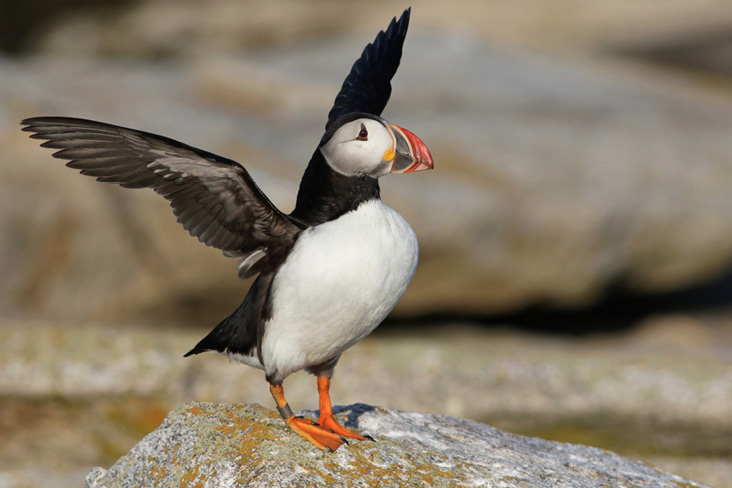
Atlantic Puffin.
You will find excellent information and further details about birding selected Maine Islands in Birdwatching in Maine: A Site Guide (Lovitch 2017).
Stratton Island, Maine
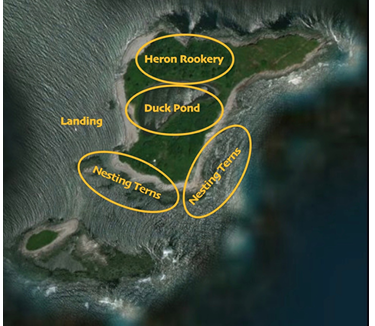
Best time to visit: June and July.
Stratton Island is home to a diverse array of nesting waterfowl, herons, and seabirds. In addition it is a magnet for rarities such as Yellow-nosed Albatross, Magnificent Frigatebird, Fork-tailed Flycatcher, Sandwich Tern, Little Gull, Franklin's Gull, Eurasian Wigeon, White-faced Ibis, Brown Pelican, and Little Egret. Breeding species include Common, Arctic, Roseate, and Least terns, Glossy Ibis, Little Blue Heron, Great Egret, Snowy Egret, Black-crowned Night-Heron, Common Eider, Gadwall, Green-winged Teal, Blue-winged Teal, American Black Duck, Mallard, Northern Shoveler, and Sora.
Landing on the island is semi-restricted. Visitors are allowed if you arrive by private boat or kayak. A biologist working for Project Puffin will meet you on the beach, discuss the nesting species and escort you to a bird blind to observe the nesting tern species. However, a better option may be to sign up for trips to the island with Maine Audubon. You can also see many of the breeding species from nearby locations such as Prout's Neck and Pine Point Beach. Many of the wading species forage at nearby hotspot Scarborough Marsh.
Links: Stratton Island Project Puffin; Pine Point Beach; Scarborough Marsh
Bailey Island, Maine
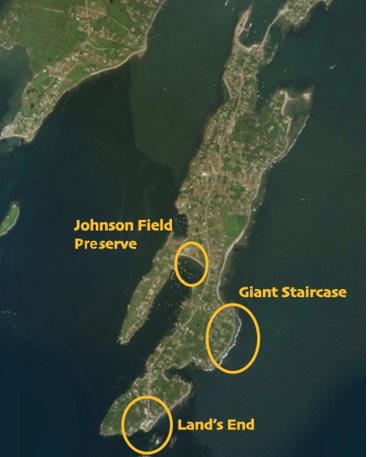
Best time to visit: spring or fall migration.
Rarities here include Willow Ptarmigan, Fork-tailed Flycatcher, Cattle Egret, Prothonotary Warbler, Blue Grosbeak, Clay-colored Sparrow, Bell's Vireo, and Red-headed Woodpecker.
There are three suggested birding locations, all of which have public parking and are excellent spots to look for migrants. First, drive to the end of the peninsula to Lands End. Here you can explore the Bailey Island Beach, and check the surrounding thickets. If you arrive early in the morning in the fall, you may have the chance to observe migrants coming in off the water and reorienting themselves with the mainland if they had been blown over the ocean overnight. Next, drive back to the McIntosh Lot Preserve and walk the trail to the Giant's Stairs, a geological structure formed of granite on the edge of the beach. The top of the Giant's Stairs is a great location to scope for sea ducks and alcids in the fall and winter. Driving back north back toward Route 24 and Brunswick, you can stop and bird at Johnson Field Preserve.
You can reach Bailey Island from Route 24 south of Brunswick.
Links: Brochure; Bailey Island
Monhegan Island, Maine
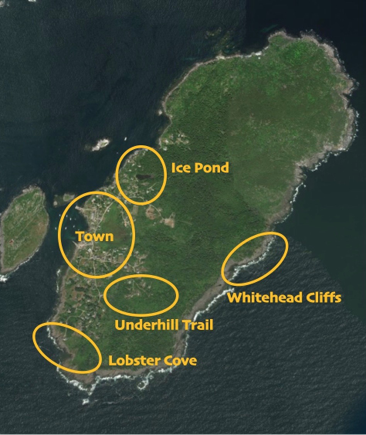
Best time to visit: spring or fall migration.
Monhegan's long list of rarities includes Magnificent Frigatebird, Corn Crake, Bridled Tern, Ivory Gull, Band-tailed Pigeon, Calliope Hummingbird, Swallow-tailed Kite, Say's Phoebe, Bell's Vireo, Virginia's, Townsend's and Hermit warblers, Lazuli Bunting, Shiny Cowbird, Black-throated Sparrow, Brewer's Sparrow, and Lark Bunting.
Most people stick to birding the southwestern half of the island, where the town is. It is suggested to start your birding route by checking the Ice Pond on the north side of town because it offers the best place to see birds looking for freshwater. When walking through town, go past the large "meadow" where the town water is pumped; it's a great spot for blackbirds, flycatchers and other insectivores. Then you can loop back through town and explore side paths. The Underhill Trail is always a favorite; it includes a slightly wooded area and is dominated by mountain ash. Some places, like the cemetery off Tribler Road, are the best for uncommon birds such as Yellow-billed Cuckoos. If time allows, walk across the island—the quickest route is to go past the lighthouse—to see the spectacular Whitehead Cliffs. They are an excellent vista for sea watching.
You can reach Monhegan Island year-round on the Monhegan Boat Line that departs from Port Clyde. By mid-May, there are also ferries departing from New Harbor and Boothbay Harbor.
Links: Monhegan Boat Line; Hardy Boat Cruises from New Harbor; Monhegan Island map
Check out Bird Observer's Monhegan: Island of Possibilities (Surner 1992)
Monhegan Island eBird Hotspot
Matinicus Island, Maine
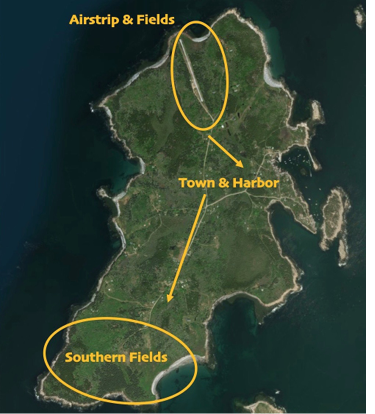
Best time to visit: spring or fall migration.
Rarities include Blue Grosbeak, White-eyed Vireo, Lark Sparrow, Dickcissel and "under-birded" so who knows what else you might find.
Catch the earliest mail flight out of Owls Head. First bird the edge of the airstrip field and then head down the main road to the fields at the southern end of the island. The main road through the center of the island offers a wide range of habitats including mature stands of trees, and open small field, and some brushy habitat. A couple of bird feeders close to the road may occasionally turn up some interesting birds as well. It is best to stick to the road as much as possible because much of the island is private property.
Getting to Matinicus Island by air is your best option, but there is a seasonal ferry that departs from Rockland. There is currently no lodging on the island unless you book a house rental online before arriving on the island.
Links: Penobscot Air; eBird Hotspot
Seal Island National Wildlife Refuge, Maine
Best time to visit: June and July.
This island is closed to any and all public landings. However, multiple boat tour companies will circumnavigate the island in search of breeding bird species: Atlantic Puffin, Razorbill, Black Guillemot, Common and Arctic terns, Great and Double Crested cormorants, Common Eider, as well as Herring and Great Black-Backed gulls. Many birders come hoping to see the single Red-billed Tropicbird that regularly frequents the island during the summer months. Other spectacular rarities include Great Knot and Ancient Murrelet both of which were first state records! Most boats trips to the island typically spend one to two hours at the island and take one and a half to two hours to travel via boat. Productive birding during the boat trip includes observation of multiple shearwaters, Wilson's Storm Petrels and sometimes jaegers.
Links: Boat Tours from Vinalhaven (John Drury); Old Quarry Ocean Adventures; Seal Island NWR eBird Hotspot
Sears Island, Maine
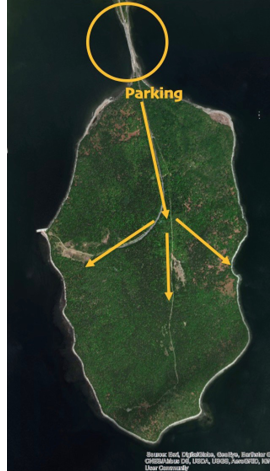
Best time to visit: spring or fall migration.
Migrant songbirds, shorebirds, and wintering ducks are the highlights of Sears Island. In the spring and fall, the thickets just before and after the causeway can be productive, so stop and bird these first. The causeway is also a great location to check for waterfowl and gulls on the water. Shortly after crossing the causeway, you will need to park your car before the barricade. You can explore many of the island's walking trails, which are maintained by the Friends of Sears Island.
Sears Island is connected to the mainland via a paved causeway that is just off Route 1 before Stockton Springs.
Links: Friends of Sears Island Trail Map; Sears Island eBird Hotspot
Machias Seal Island, Canada
Best time to visit: June and July. (Plan far ahead as trips fill up quickly.)
Machias Seal Island is home to the largest seabird colony in the Gulf of Maine. Breeding Species are Atlantic Puffin, Razorbill, Common Murre, Common and Arctic terns, and most recently Northern Gannet. You can land on the island only with tour groups out of Cutler and Grand Manan Island. You will get to go into a bird blind and observe seabirds at close range. Rarities include Tufted Puffin, Ancient Murrelet, Red-billed Tropicbird, and Bridled Tern. In addition, this island occasionally receives a "fallout" of migrant songbirds during the spring and fall. Photographs by Ralph Eldridge, one of the island's lighthouse keepers, are certainly worth a look.
Bold Coast Tours from Cutler.
Sea Watch Tours from Grand Manan
Ralph Eldridge's Warbler Fallout Pictures
Check out Bird Observer's Machias Seal Island (Butler 1977)
References
- Andrews, G. and K. T. Blackshaw. 2018. Birding Nantucket, Eighth Edition. Nantucket: CreateSpace Independent Publishing Platform.
- Butler, P. 1977. Machias Seal Island. Bird Observer 5 (3): 72-75. https://www.birdobserver.org/Portals/0/PDF_open/bo05-3-web.pdf?ver=2017-02-10-105540-730#view=Fit
- Fox, R. 2000. Block Island. Bird Observer 28 (1): 22–27. https://www.birdobserver.org/Portals/0/PDF_open/bo28-1-web.pdf?ver=2017-02-10-105719-573#view=Fit
- Lovitch, D. J. 2017. Birdwatching in Maine: a Site Guide. Lebanon, New Hampshire: University Press of New England.
- Nove, J. 2001. Birding the Boston Harbor Islands. Bird Observer 29 (3): 173–186. https://www.birdobserver.org/Portals/0/PDF_open/bo29-3-web.pdf?ver=2017-02-10-105724-620#view=Fit
- Sargent, R. M. 1979. A Guide to Birding on Martha's Vineyard. Bird Observer 7 (2): 52–60. https://www.birdobserver.org/Portals/0/PDF_open/bo07-2-web.pdf?ver=2017-02-10-105546-870#view=Fit
- Surner, S. 1992. Monhegan: Island of Possibilities. Bird Observer 20 (4): 180–185.https://www.birdobserver.org/Portals/0/PDF_open/bo20-4-web.pdf?ver=2017-02-10-105645-620#view=Fit
- Veit, R. R. 1976. Where to Go on Nantucket. Bird Observer 4 (5): 131–133. https://www.birdobserver.org/Portals/0/PDF_open/bo04-5-web.pdf?ver=2017-02-10-105534-777#view=Fit
- Whiting, S. B. and B. B. Pesch. 2007. Vineyard Birds II. Martha's Vineyard: Where and What to See on Martha's Vineyard. Martha's Vineyard, Massachusetts: Vineyard Stories.
This article could not have been completed without the help of all the contributors who provided information and some text for this "quick" guide: Ginger Andrews, Seth Benz, Ken Blackshaw, Ian Davies, Ralph Eldridge, Tina Green, Doug Hitchcox, Marshall Iliff, Lanny McDowell, Wayne R. Petersen, Jeremiah Trimble, and Peter Trimble. Special thanks to Isabel Brofsky, who helped create many of the maps.
Keenan Yakola is a fellow with the Northeast Climate Science Center, a master's candidate in the Department of Environmental Conservation at the University of Massachusetts Amherst, and during the summer months, the Supervisor of Seal Island National Wildlife Refuge with Project Puffin. Keenan is also a native of Cape Cod, Massachusetts; some of his first experiences with birds included working with Mass Audubon's Wellfleet Bay Wildlife Sanctuary, the Cape Cod National Seashore, and local bird bander Susan Finnegan. He has also spent time working with birds in the Peruvian Amazon and Andes, Kenya and Tanzania, as well as several other locations across the United States.